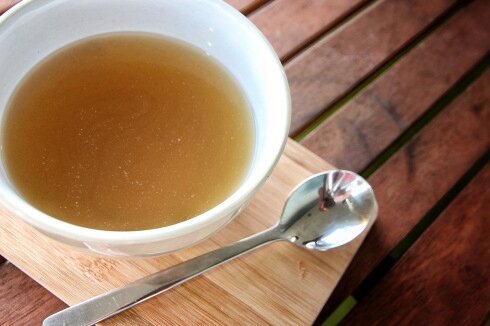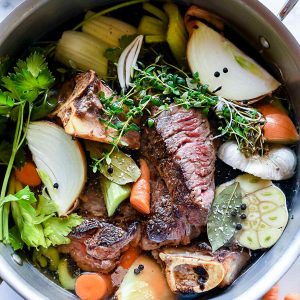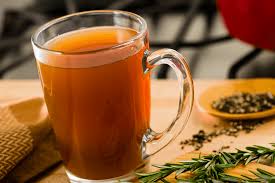Beef Consomme Vs Broth Vs Stock
You already know beef is what's for dinner. But you don't actually have to sear a steak or grill those burgers in order to get the umami flavor you crave! There are a slew of richly flavored beef products and ingredients out there--and beef broth, beef stock, and beef consommé are just a few of them.
What actually are these three liquids though? Aren't they all just different words for the same thing? Not exactly!
Join us as we take a deep dive into the soup pot to discover what makes each of these beefy infusions unique and how best to use each one to maximize your culinary efforts.
What is Beef Broth?

Beef broth is first up as it is the lightest of the three liquids we're going to cover. Broth requires the least amount of cooking time and usually contains the fewest number of ingredients, but nonetheless produces a richly flavored liquid.
How is Beef Broth Made?
Broth is often made using cuts of meat such as beef shanks or short ribs which tend to be tough and otherwise unpleasant in texture unless cooked for a lengthy period of time. These types of cuts, though, always have amazing flavor. Therefore, making broth is an excellent way to put them to good use! While cooking over low heat, the slowly simmering meat is able to break down just enough to release its flavor and nutrition into the liquid, and thus, beef broth is born.
Though beef bones themselves are not a key component when making beef broth (they're more vital to stock-making, as we'll learn shortly), they are sometimes used if they have a decent amount of meat left on them. And while it's possible to make simple beef broth with meat and meat alone, oftentimes another ingredient such as onion or celery is added, so as to enhance the mild flavor of the broth.
The biggest key to a successful beef broth is that the meat is slowly and relatively briefly simmered, as this allows the maximum amount of nutrients to be drawn out of the meat and into the liquid. If the broth is allowed to boil or is cooked for a very long time, too many particles from the solids break off and get dispersed throughout the liquid, causing it to become murky.
What Does Beef Broth Taste Like?
This gentle, slow simmer and simple ingredient list results in beef broth which has a clean beef flavor and little taste of any other vegetables, seasonings, or salt. Due to the brief cooking time, beef broth will have a lower fat and gelatin content than stock or consommé and may even taste "watery" when compared to the two!
How is Beef Broth Used?
Beef broth's lack of bold flavors and salinity is important because of the wide range of ways in which beef broth may be used. Maybe the broth is going to be reduced for a red wine sauce, or perhaps it will be for a soup that is to be seasoned with soy sauce. If the broth is already salty or heavily flavored to start with, it will be overly salted by the time the final dish is finished or unable to complement the ingredients that are to follow.
At times, beef broth is consumed on its own as a soup or a beverage, but it is more often used as a base ingredient for other dishes such as soups, stews, sauces, gravies, cooked grains, and beyond!
What is Beef Stock?

Unlike broth, beef stock relies on the simmering of beef bones to develop its flavor. The bones may or may not have scraps of meat left on them, but either way, can be used to produce an extremely richly flavored stock. Stock tends to be richer than beef broth, yet with a less intense beef flavor. How does that work? Allow us to explain.
How is Beef Stock Made?
When making stock, the main ingredient is bones bones bones! Many times, the bones are roasted in a very hot oven beforehand, as this caramelizes any meat scraps that remain on the bones. The caramelization leads to an extremely rich, full, and roasty-toasty flavor in the final stock.
Generally speaking, all stocks (including fish and chicken stock) are simmered for far longer than broths. This extra time is necessary so that the hot liquid can penetrate the bones and draw out all of the nutritious collagen and marrow. As these things slowly become dissolved in the stock itself, they impart a thick, gelatinous texture to the liquid which is especially apparent when the stock is cooled.
Beef stock also tends to contain more and a wider range of ingredients than broth. Where beef broth may contain just cuts of beef and a few pieces of mildly flavored vegetables, stock will often contain more additions like root vegetables, herbs such as thyme and parsley, aromatics like bay leaves or garlic, and spices such as peppercorns or dried chiles.
What Does Beef Stock Taste Like?
The final stock will be richly colored with a deeply savory flavor that may taste herbal or spicy depending on the other ingredients used. Although beef stock has a stronger flavor than beef broth, it tends to taste less beefy due to the fact that it is made with a higher proportion of bones than actual meat. And just like broth, stock also tends to be minimally salted.
How is Beef Stock Used?
Beef stock is most often used as an ingredient in other dishes rather than eaten on its own. It is ideal for use in braised meat dishes, stews, soups, or gravies--especially those in which actual cuts of meat or other beef flavorings will be added. Stock is perfect for bringing that slow simmered, deeply roasted flavor to the table, making any dish taste as if it's been cooking all day when in fact, it was only the stock!
What is Beef Consommé?

The French word consommé translates to "complete" and that's exactly what this savory liquid is! Consommé is regular beef broth which has been taken a step further and gone through a process known as clarification. This results in a beautifully pure broth that has the most pronounced beef flavor you'll find anywhere.
How is Beef Consommé Made?
First things first, when making beef consommé you must start with a quality beef broth which will provide a good base of flavor to start from. Egg whites are whipped to stiff peaks and combined with minced or ground beef. Then, the next step is to mix minced vegetables in with the egg whites and beef until the mixture is evenly distributed.
This mixture is then carefully stirred into the simmering broth, where it will quickly cook and coagulate within the top layers or the liquid. Due to the way it floats atop the surface, this special mixture of egg whites and other ingredients is known as a raft.
Think of this raft as a giant filter! As the broth simmers and circulates around within the pot of broth, it passes through the mass of egg whites, minced meat, and minced mixed vegetables. As the liquid is filtered through, tiny floating particles and other impurities are caught up in the mixture and thus are removed from the body of the broth itself. Once this clarifying process is complete, the entire mixture is strained through fine cheesecloth to remove the raft and all of the bits with it.
What Does Beef Consommé Taste Like?
The result? A crystal clear, richly colored broth with intense beef flavor! Clarified beef broth has a thicker consistency than regular broth due to its longer cook time as well as the addition of ground beef during the clarifying process. In addition, the removal of impurities and fine particulates from the consommé means that there is nothing in the way to distract from the pure beef flavor.
What is Beef Consommé Used For?
Due to the particular care and extra time that goes into making it perfectly clear and pure of flavor, beef consommé is most often eaten as a dish unto itself so that these unique characteristics can be appreciated to the fullest. Some people serve beef consommé over uniformly chopped vegetables that have been poached or steamed until they are just crisp tender, so as to add texture to the dish without marring the integrity of the clarified broth.
Consommé is also used to make aspic, which is a very classic dish of French cuisine. When consommé is chilled, the high collagen content allows it to congeal into a savory jelly. Aspic is often molded into artful shapes and may have other ingredients suspended within such as cuts of meat or cooked vegetables.
Beef Broth vs. Beef Stock vs. Beef Consommé: FAQ's!

Now that we understand how these three items compare to one another, let's get into some related and commonly asked questions about our trio of savory beef elixirs.
Can You Substitute Beef Broth With Either Beef Stock or Beef Consommé?
Absolutely! While each of these three do have unique characteristics, they can typically be used interchangeably so long as you keep a few factors in mind.
If you are looking to substitute beef broth with stock or consommé, you should dilute either of these with some water to achieve a level of flavor that is more in line with that of beef broth.
What happens if your recipe calls for beef consommé, but you only have beef broth or stock? While you can substitute beef consommé with either broth or stock, bear in mind that neither of these liquids will offer the same degree of clarity or quite the same intensity of beef flavor.
What's a Vegan Substitute for Beef Broth?
While there's certainly no way to actually make beef broth that is vegan or vegetarian, there are some great options which can be used to replace beef broth in a recipe!
Roasted vegetable broth or mushroom consommé are two options which will impart a similar umami rich flavor without the use of animal products. Using additional ingredients such as soy sauce, vegan Worcestershire sauce, or even just a few dried mushrooms will also add a ton of savory, plant-based taste to whatever you're cooking.
Can You Freeze Beef Broth, Stock, and Consommé?
Yes! Broths and stocks–whether beef, chicken, vegetable, or anything else–are perfect candidates for freezer storage. This is great news in the event that you decide to embark on making homemade broth or stock, as it enables you to make one big batch and keep it safely stored for many months to come.
Just transfer the remaining liquid into a container which is able to seal tightly, and be sure to leave several inches of headspace at the top to allow for the expansion of the liquid during freezing. If you open a container of store bought broth, stock, or consommé, you can easily store this in the same manner as well.
Is There a Difference Between Beef Stock and Beef Bone Broth?
This one is a doozy of a topic, which continues to be debated!
At the core though, the main difference between beef stock and bone broth lies in the fact that stock is made to function as a component of another dish, while bone broth is fully intended to be consumed on its own. Beef bone broth is also highly nutrition oriented, not only taking on the majority of its flavor by way of simmering bones, but it is key that bone broth takes on the maximum amount of collagen and nutrients as well.
Stock, while plenty flavorful and tasty, is generally not meant to be consumed as is, while bone broth is finished in such a way that it makes for a nutritious, pleasant-to-sip beverage.
What is Condensed Beef Broth?
Condensed beef broth is broth which has been reduced, which essentially means simmered for additional time after cooking so as to remove extra water. This super concentrated beef broth will have a stronger flavor than regular beef broth. Store bought condensed broth often instructs to add an equal proportion of water in order to reconstitute it to a more typical level of concentration, but depending on the recipe you are using it in, you may opt to add the concentrate on its own for maximum flavor.
What is Bouillon?
While bouillon is actually the French word for "broth", it more often refers to broth which has been concentrated and dehydrated in a certain way. When shopping for bouillon, you'll likely be able to choose from bouillon cubes, powders, or pastes--each of which should be mixed with water in order to be brought back to the consistency and flavor concentration of regular beef broth.
The positive side of bouillon is that it has an extremely long shelf life and can quickly add savory flavor to any dish. The main downside, however, is that bouillon is typically quite high in sodium, even once reconstituted with water.
Beef Broth vs. Beef Stock vs. Beef Consommé: Summary of Key Differences
To finish up, let's review the main distinctions between these three types of savory liquids:
- Beef Broth is the simplest of the bunch, only requiring some cuts of beef (or perhaps very meaty bones), a few mild-tasting vegetables, and water. After a brief period of simmering, the beef broth has a strong flavor of beef and very little else. Beef broth can be eaten as is but is more often used as a base for another meat dish such as beef soup or brown gravy.
- Beef Stock derives the majority of its beef flavor from actual bones and has a much larger range of additional ingredients as opposed to beef broth. These ingredients are often roasted before being simmered in order to develop deep, caramelly flavors and produce a stock that is deep in color and taste. Once again, stock is rarely consumed as a standalone dish or beverage, but rather is best used as a braising liquid, stew base, or starter for a sauce.
- Beef Consommé is the most complex of the processes and tends to have the most pure beef flavor of them all. Consommé starts out as beef broth, which is then treated in such a way to remove any cloudiness and focus the flavor. The resultant broth is clear in appearance and pure of beef taste. Consommé is not typically used as a recipe ingredient but is usually served on its own or with simple vegetable accompaniments.
As you can see, all of these broths are made according to a very similar procedure, yet they each end up having unique characteristics and are best used in different ways. Despite their distinctions, these three liquids generally make wonderful substitutions for one another and no matter what, will impart savory beef flavor into any recipe or dish.
schraderthisere01.blogspot.com
Source: https://thedaringkitchen.com/beef-stock-vs-beef-broth-vs-beef-consomme/
0 Response to "Beef Consomme Vs Broth Vs Stock"
Postar um comentário